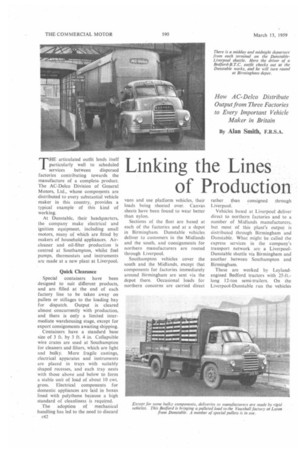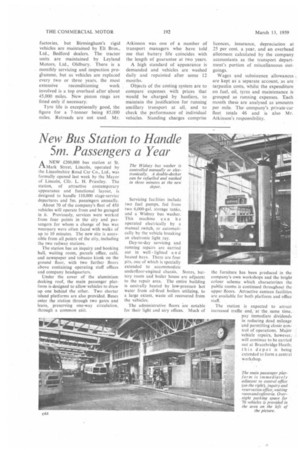Linking the Lines of Production
Page 120

Page 121

Page 122

If you've noticed an error in this article please click here to report it so we can fix it.
THE articulated outfit lends itself particularly well to scheduled
services between dispersed factories contributing towards the manufacture of a completeproduct. The AC-Delco Division of General Motors, Ltd., whose components are distributed to every substantial vehicle maker in this country, provides a typical example of this kind of working.
At Dunstable, their headquarters, the company make electrical and ignition equipment, including small motors, many of which are fitted by makers of household appliances. Aircleaner and oil-filter production is centred at Southampton, whilst fuel pumps, thermostats and instruments are made at a new plant at Liverpool.
Quick Clearance
Special containers have been designed to suit different products, and are filled at the end of each factory line to be taken away on pallets or stillages to the loading bay for dispatch. Output is cleared almost concurrently with production, and there is only a limited intermediate warehousing stage, except for export consignments awaiting shipping.
Containers have a standard base size of 3 ft. by 3 ft. 4 in. Collapsible wire crates are used at Southampton for cleaners and filters, which are light and bulky. More fragile castings, electrical apparatus and instruments are placed in trays with suitably shaped recesses, and each tray nests with those above and below to form a stable unit of load of about 10 cwt. gross. Electrical components for domestic appliances are laid in boxes lined with polythene because a high standard of cleanliness is required.
The adoption of mechanical handling has led to the need to discard c42 vans and use platform vehicles, their loads being sheeted over. Canvas sheets have been found to wear better than nylon.
Sections of the fleet are based at each of the factories and at a depot in Birmingham. Dunstable vehicles deliver to customers in the Midlands and the south, and consignments for northern manufacturers are routed through Liverpool.
Southampton vehicles cover the south and the Midlands, except that components for factories immediately around Birmingham are sent via the depot there. Occasional loads for northern concerns are carried direct
rather than consigned through Liverpool.
Vehicles based at Liverpool deliver direct to northern factories and to a number of Midlands manufacturers, but most of this plant's output is distributed through Birmingham and Dunstable. What might be called the express services in the company's transport network are a LiverpoolDunstable shuttle via Birmingham and another between Southampton and Birmingham.
These are worked by Leylandengined Bedford tractors with 25-ft.long 12-ton semi-trailers. On the Liverpool-Dunstable run the vehicles of the B.T.C. type, two tractors five semi-trailers being in use a third tractor held in reserve. artures are made at midnight and day from each terminal, and ers are changed at Birmingham, re their day starts and finishes. ehicles from Liverpool partly ad at Birmingham. Products for sin Midlands manufacturers are :n off and the space is made good materials needed by the tstable factory. North-bound loads ost wholly comprise }materials n Dunstable for the Liverpool It. The complete cycle is employed apacity.
Varying Frequency
he Southampton Birmingham :fle• is worked by a tractor and semi-trailers with Scammell pling gear. The tractor leaves ningham nightly with factory erials and returns from thampton with products for Ilands manufacturers. Other ides operate from the four estabments, delivering direct to manuurers with varying degrees of Riency according to the size of :omers' demands. Big manu.urers take a load every day.
lost of the vehicles are Bedfords. Dunstable there are three 7-ton p-siders, four 5-tonners (one of ch is a Commer), and a 5-ton and two 25-cwt. vans. A 7-ton tipper is used to bring in coal from the railway yard.
The Southampton fleet comprises, in addition to the units engaged on the Birmingham shuttle, a tractor and two semi-trailers, three 7-tonners, two 6-tonners, three 5-tonners and a 3-tonner. The articulated outfit is chiefly engaged on delivering to the bigger manufacturers. Its size allows large consignments of cleaners and filters to be carried.
At Liverpool are a 7-tortner and a 25-cwt. van, whilst 10-12-cwt. vans and 1-Iillman Husky utilities are employed at each point as runabouts. Major units of the fleet cover 3,000 miles a month.
Materials Intake
Apart from small postal dispatches and a few parcels sent by British Road Services, all output is carried under C licence, and on return journeys the capacity not taken up by empties is used to transport into the factories 40 per cent. of their material requirements.
Collection of empties cannot always be achieved with the same flow as deliveries, and sometimes containers mount up at customers' premises. Each day, however, three Dunstable vehicles and two from Southampton run to the London docks with export crates which, when taken off, leave platform space completely free, and it is fortuitous to be able to employ them to clear stacks of empties of which too many have accumulated.
It is intended to extend the operation of articulated units. Semi-trailers currently in use have roof and end panels, the sides being closed by curtains. Decking is of timber.
This type of construction is being applied to three specially designed Bedford 6-ton lorries due for aelivery soon. Based on the passenger chassis, with bodywork by B. Walker and Son, Ltd., Watford, these vehicles will have the largest permissible loading space in an endeavour to deal more economically with the bulky products made at Southampton.
Apart from five Perkins-engined 5 tonners at Dunstable and Southampton, the tractors are the only oilers in the fleet, petrol vehicles having been retained so far largely because of a deficiency in suitable servicing facilities throughout the country.
Vital Regularity
Mr. Ron Atkinson, transport superintendent, emphasized to me that because customers held only tenuous stocks, the regularity of the fleet's operation was as vital to them as the running of their own production lines. If a petrol vehicle broke down, a driver could normally put it right himself, but oilers required expert attention which was not as easy to secure as he thought operators had a right to expect.
Nevertheless, the cost savings resulting from using oilers had now caused the company to reappraise policy, and future deliveries would not be of petrol vehicles. The difference in fuel-consumption rates between the petrol and oil-engined 5-tonners is more than 40 per cent. at 12 m.p.g. and 17 m.p.g. respectively. Petrol 7-tonners average 9 m.p.g. and the " artics " 11 m.p.g.
A further vehicle is a mobile lecture outfit with Spurling bodywork based on a 3-ton chassis. This is constantly on tour throughout the country, giving two film shows a week to motor agents and users of AC-Delco equipment.
Servicing facilities exist at the c43 factories, but Birmingham's rigid vehicles arc maintained by Elt Bros., Ltd., Bedford dealers. The tractor units are maintained by Leyland Motors, Ltd., Oldbury. There is a monthly servicing and inspection programme, but as vehicles are replaced every two or three years, the most extensive reconditioning work involved is a top overhaul after about 45,000 miles. New piston rings are fitted only if necessary.
Tyre life is exceptionally good, the figure for a 7-tonner being 85,000 miles. Retreads are not used. Mr.
Atkinson was one of a number of transport managers who have told• me that battery life coincides with the length of guarantee at two years.
A high standard of appearance is demanded and vehicles are washed daily and repainted after some 12 months.
Objects of the costing system are to compare expenses with prices that would be charged by hauliers, to maintain the justification for running ancillary transport at all, and to check the performance of individual vehicles. Standing charges comprise licences, insurance, depreciation at 25 per cent. a year, and an overhead allotment calculated by the company accountants as the transport department's portion of miscellaneous outgoings.
Wages and subsistence allowances are kept as a separate account, as are tarpaulin costs, whilst the expenditure on fuel, oil, tyres and maintenance is grouped as running expenses. Each month these are analysed as amounts per mile. The company's private-car fleet totals 46 and is also Mr. Atkinson's responsibility.




















































































































































































